In the past, media art was a largely unfamiliar genre on the periphery of the Korean art world. Today, it takes center stage of the mainstream arts and culture scene, as innovators employ cutting-edge technology to explore its potential to understand the world through a different lens.
In June 2023, Ayoung Kim’s video work Delivery Dancer’s Sphere earned her the Golden Nica in the “New Animation Art” category at Prix Ars Electronica, the longest-running annual competition for electronic and interactive art, computer animation, and digital culture. It has been a part of Ars Electronica, the world’s largest media art festival, since 1987. Around the same time that Kim became the first Korean to win one of the festival’s top prizes, traditional Swiss watchmaker Jaeger-LeCoultre invited Yiyun Kang as the first Asian digital media artist to Made of Makers. Through this program, launched in 2022, the luxury brand commissions artworks from artists, designers, and craftspeople in disciplines outside watchmaking. The theme for 2023 was “Golden Ratio” for which Kang created a large-scale 3D video sculpture titled Origin.
The growing number of Korean media artists in the global spotlight is the result of systematic support given to the genre’s active and leading figures. The foundation they laid is a source of inspiration and creativity for young artists today.
Vanguards
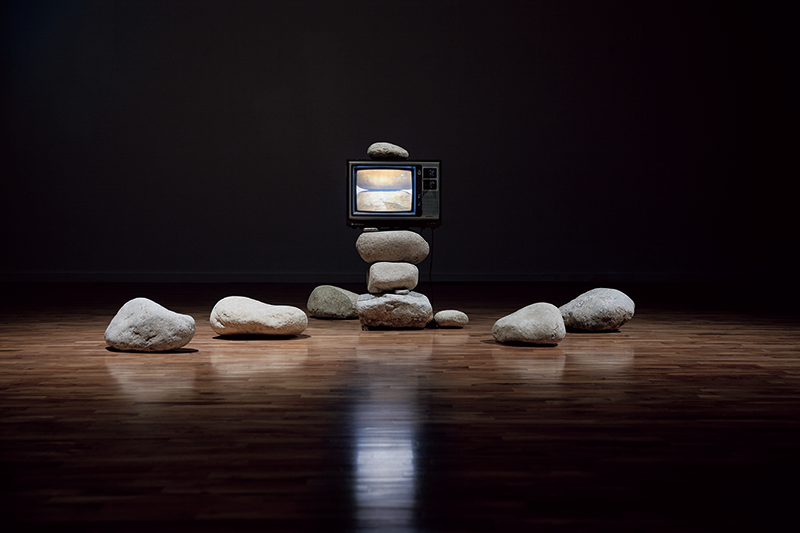
Untitled (TV Stone Tower). Park Hyun-ki. 1980. TV & 17 stone pieces. Variable size.
One of the representative works of Park Hyun-ki, known as one of the pioneers of Korean video art. Park structured the dichotomous boundaries between the natural and artificial, the real and the virtual world.
Courtesy of Busan Museum of Art
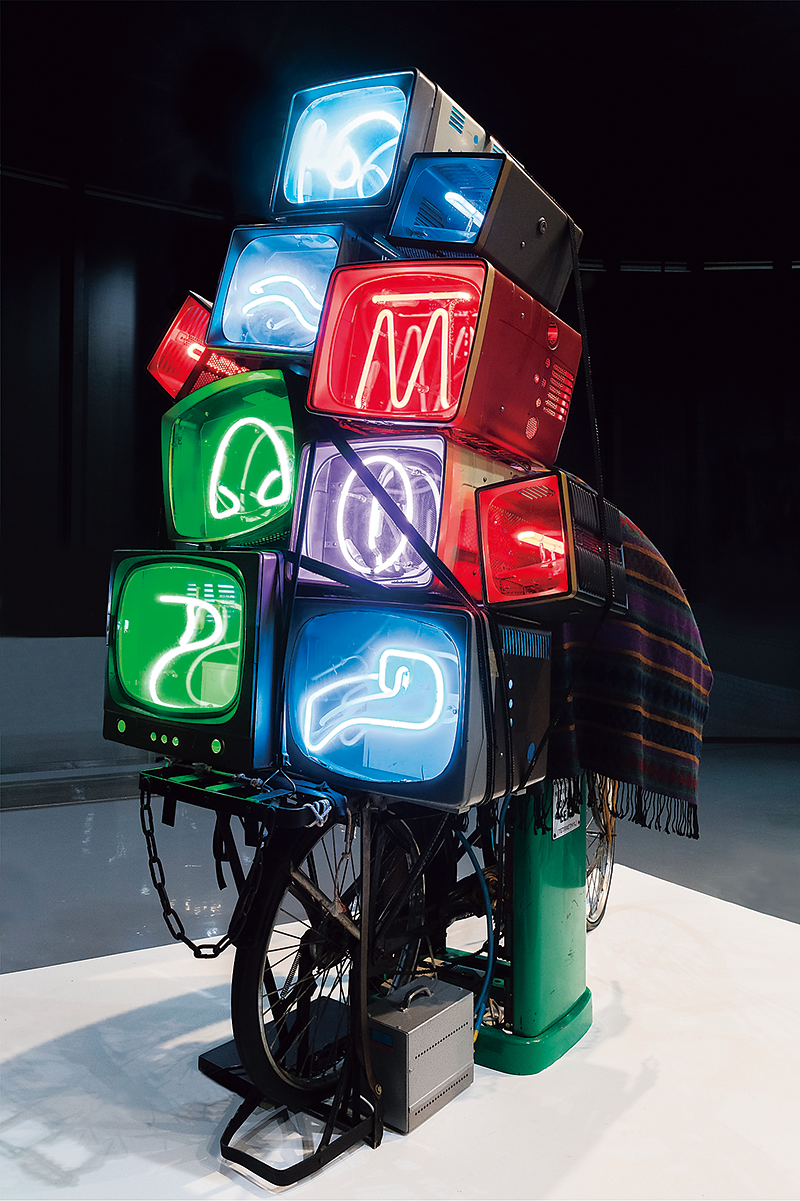
Rehabilitation of Genghis-Khan. Nam June Paik. 1993. One CRT TV monitor, ten steel TV cases, neon tube, bicycle, diving helmet, gasoline pump, plastic pipe, cape, rope, single-channel video, color, silence, LD. 217 × 110 × 211 cm.
The work is a visual representation of a broadband electronic highway, a modern version of the ancient Silk Road used by Eurasian traders.
© Nam June Paik Estate, Courtesy of Nam June Paik Art Center
With his innovative imagination, Nam June Paik (1932–2006) was undoubtedly one of the greatest new media artists and a profound influence on the field. He began to explore incorporating new media into art while studying European philosophy and modern music in Germany, where he mingled with contemporaries in the avant-garde and counterculture movements. He made his debut in 1963 with an exhibition titled Exposition of Music – Electronic Television, held at Galerie Parnass in Wuppertal, Germany. Paik’s work often involved the manipulation of televisions and the distortion of images. This signified the dismantling of the monopolistic power of mass media through the one-way transmission of information and its reception by the public.
Paik forged an extraordinary artistic path with works that combined video footage, sculpture, and installation, or fused music and performance with the human body. In collaboration with Shuya Abe, he also created a one-of-a-kind video synthesizer that allowed him to edit seven different video sources simultaneously—in real time. He envisioned a cybernetic world where humans and machines would coexist in a mutually influential relationship. Paik also explored digital communication in situations requiring interaction among multiple parties. He translated this into a project, titled Good Morning, Mr. Orwell, that achieved the convergence of nature and technology and the integration of Eastern and Western cultures. The live international satellite installation linked New York and Paris and was intended as satire on the vision of a dystopian future as described in George Orwell’s seminal work, 1984. Paik’s creations and statements, which today seem almost prophetic, are still relevant and talked about because of their clear connection with the future.
Park Hyun-ki (1942–2000), a pioneer of Korean video art who debuted in the 1970s, took a different approach to creating artworks, using TV sets. He created installations made of televisions and natural materials such as rocks and wood. The televisions displayed images of rocks or trees, showing the connection between the real and the virtual world. By questioning what is real, he expanded people’s awareness and consciousness. A notable aspect of Park’s works is his method of stacking materials, an adaptation of a traditional Korean construction technique. Through the juxtaposition of natural materials and objects of civilization, he sought to deliver novelty and stir new ways of looking at art. This perspective is still valid in contemporary media art.
Dedicated Institutions
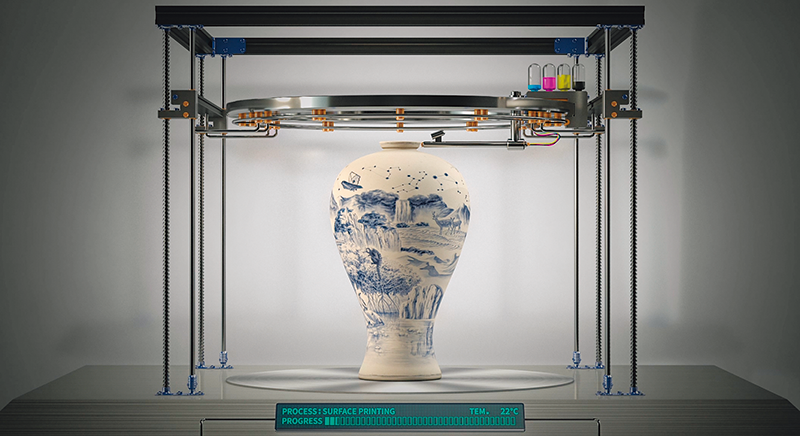
Universal Manufacture. Zin Ki-jong, Cha Dong-hoon, Kang Ji-young. 2023. Single-channel video. 6 minutes 36 seconds.
Universal Manufacture was part of the Pale Blue Dot exhibition held at the KF XR Gallery in 2023. It contemplates biodiversity and sustainability with a state-of-the-art virtual 3D printer and traditional pottery as the medium. The environment was the main theme of the gallery’s inaugural exhibition.
© Korea Foundation
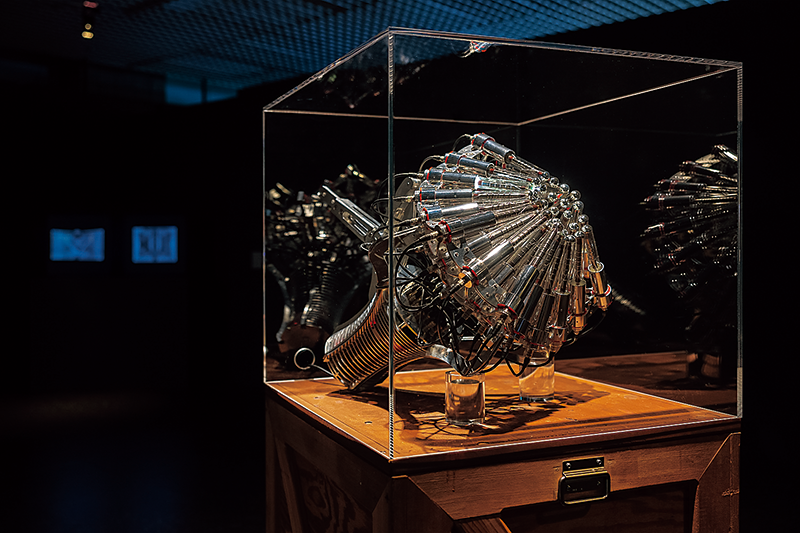
Argos. Yunchul Kim. 2018. Geiger–Müller tube, glass, aluminum, microcontroller. 48 × 40 × 40 cm.
One of the artworks showcased at the exhibition Cabinet of the Ephemeral – Collecting Media Art hosted by Art Center Nabi in September 2023. It is a muon particle detector consisting of 41 channels that flash whenever it detects a muon particle emitted from space. Kim explores the artistic potential of fluid mechanics and metamaterials.
Courtesy of Art Center Nabi; Photo by Seoul Metropolitan Government, Seoul Council of Art Museums
The year 2000 marked a watershed for Korean media art, with the inauguration of venues and events dedicated to the genre, such as the Seoul Mediacity Biennale hosted by the Seoul Museum of Art; Art Center Nabi, formerly the SK Walkerhill Art Museum; and Ilju Art House, which was located in the Heungkuk Life Insurance building in Seoul’s Gwanghwamun area.
The Seoul Mediacity Biennale highlights the contemporaneity and experimental spirit of art amid a changing media landscape. This year saw the 12th edition of the event, initially called Media City Seoul. At the time of its inception, a controversy arose regarding the government’s policy objective of promoting Korea’s rapid progress in the ICT and technology sectors. However, with a newly defined focus on media art, the event has helped to raise public awareness of the importance of media art as a contemporary art genre.
The SK Walkerhill Art Museum focused on traditional art genres, but since its rebirth as Art Center Nabi, it provides fertile ground for the diversity of media art to flourish. With a critical eye on the latest technologies, it sponsors creators in the field. In the early 21st century, when media art was still a somewhat unfamiliar genre, the venue played an important role as a space where pioneers pursuing innovative ideas could network, inspire one another, and engage in diverse artistic explorations. Early on, it supported the establishment of the media art community INP (Interactivity & Practice), which included many of today’s established artists.
Likewise, Ilju Art House offered resources and networking opportunities for media artists at a time when the art form lacked a firm footing and recognition. It consisted of a media gallery that displayed interpretations of digital culture; an archive of video materials and publications on media art; and a studio that furnished media equipment, which most people could not afford to own, as well as related educational programs. Until its closure in 2006, it focused on exploring the potential of media art in the public sphere and providing practical support to creators. It also launched the “Media Raiders” program to discover promising artists and help them establish their careers.
Support Initiatives
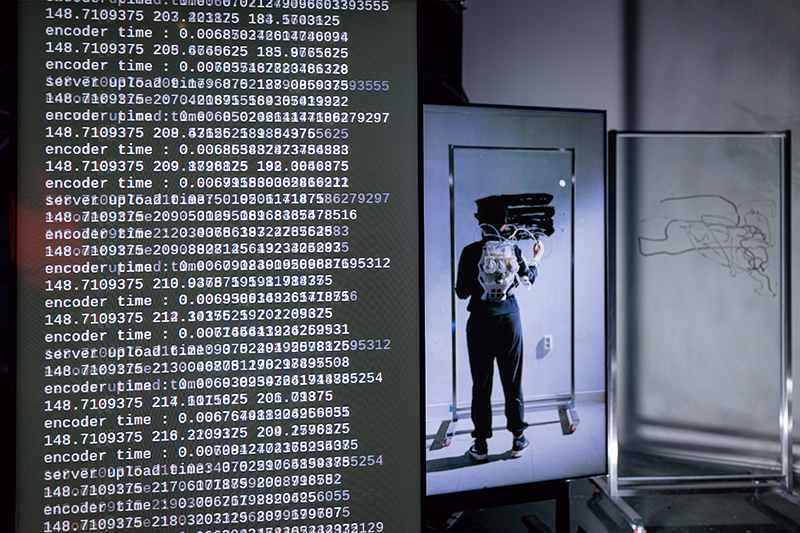
Drawing Suit 02. Inkang Lee. 2022. Remote multi-connected drawing suit with wearable exoskeleton technology. An interactive drawing was performed with a 3-channel video lasting 15 minutes.
After sustaining an injury as an amateur boxer, Inkang Lee began to experiment with wearable technology that could perform body movements. The photo is from the Unfold X 2022 festival, which highlighted innovative artistic creations incorporating cutting-edge technology. The interactive performance involves the artist and participants producing a drawing using digitized motion data.
© Seoul Foundation for Arts and Culture
In 2015, the Asia Culture Center (ACC) opened in Gwangju, South Jeolla Province, with the goal of promoting cultural exchange and collaboration with other Asian countries. Its Arts & Creative Technology Center (ACT) is responsible for the research, production, exhibition, and distribution of arts and cultural content that creatively expresses and combines cutting-edge technology, cultural diversity, and Asian traditions. It serves as a platform for artists, designers, engineers, and researchers to stretch their imaginations.
In 2010, the Da Vinci Idea Contest was launched at Seoul Art Space Geumcheon, which is operated by the Seoul Foundation for Arts and Culture (SFAC). What sets it apart from other publicly funded competitions is its focus on technology-based creative ideas with commercial potential. Starting in 2014, it expanded its scope to include a media art festival featuring lectures, workshops, and guest appearances by foreign artists. It has since been renamed Unfold X and is hosted directly by the SFAC as an art and technology festival.
The Nam June Paik Art Center; Hyundai Motor Company’s ZER01NE DAY, a platform for creative talents; and the Paradise Cultural Foundation’s Paradise Art Lab also play a key role in enriching the domestic media art scene.
The rapid growth of the media art market has raised concerns that it may be a passing fad or result in the mass production of kitschy creations. But it is important to explore the significance and potential, as well as the risks, of contemporary technologies and their profound impact on our daily lives. Media art is a meaningful art form that visualizes this exploration process and its outcome. It has been and continues to be at the forefront of the art scene, especially in a country as technologically advanced as Korea.